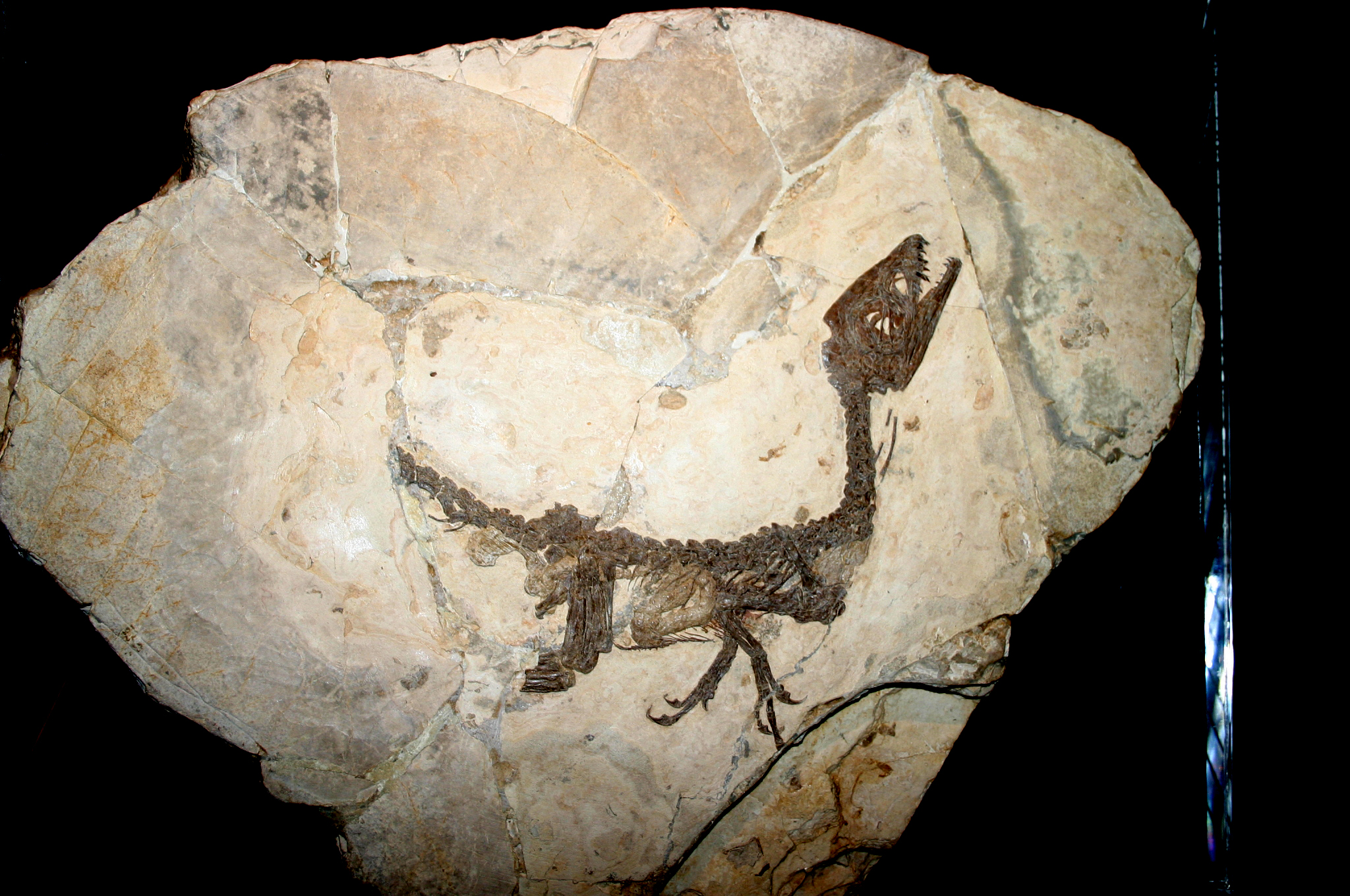- Scipionyx
Taxobox
name = "Scipionyx"
fossil_range =Early Cretaceous

image_width = 250px
image_caption = "Scipionyx samniticus" fossil at the Museo Civico di Storia Naturale, in Milan, Italy.
regnum =Animal ia
phylum = Chordata
classis = Sauropsida
superordo =Dinosaur ia
ordo =Saurischia
subordo =Theropoda
unranked_familia =Coelurosauria
genus = "Scipionyx"
genus_authority= dal Sasso & Signore, 1998
subdivision_ranks=Species
subdivision=
*"S. samniticus" dal Sasso & Signore, 1998 (type)"Scipionyx" is a very small
genus oftheropod dinosaur from the EarlyCretaceous ofItaly , around 113 million years ago. There has been only one skeleton discovered, which is notable for the preservation of soft tissue and internal organs. It is thefossil of a juvenile only a fewinch es long. Adult size is estimated to be 2metres (approx. 6 feet). The name "Scipionyx" comes from the Latin word "Scipio" and the Greek "onyx", meaning "Scipio's claw", and forScipione Breislak ,cite web| last = Poling| first = Jeff| authorlink =| coauthors =| title = Skippy the dinosaur| work = | publisher = Journal of Dinosaur Paleontology| date = 1998| url = http://www.dinosauria.com/jdp/misc/scipionyx.html| format =| doi =| accessdate = 2007-03-01 ] the geologist who wrote the first description of the formation in which the fossil was found. The specific name "samniticus" means "From the Samnium", the Latin name of the region around Pietraroja. The specimen is also popularly nicknamed "Skippy"."Scipionyx" was discovered in the spring of 1981 by Giovanni Todesco, an amateur paleontologist, near
Pietraroja , approximately 30 miles fromNaples . The fossils were preserved in the Pietraroia limestone formation, well known for unusually well-preserved fossils. Todesco thought the remains belonged to that of a fossil bird. Unaware of the importance of his findings, he kept the strange fossil in the basement of his house until 1992 when he met two paleontologists,Cristiano dal Sasso of the Natural History Museum of Milan andMarco Signore of theUniversity of Naples Federico II , who identified it as the first Italian dinosaur. The magazine "Oggi " gave the tiny dinosaur the nickname "Ciro", a typical Neapolitan name. In 1998, "Scipionyx" made the front cover of "Nature". [Dal Sasso, C. and Signore, M. (1998). "Exceptional soft tissue preservation in a theropod dinosaur from Italy." "Nature", 392: 383-387.]Classification
"Scipionyx" is classified as a coelurosaurid
theropod . Because the only remains recovered belong to that of a juvenile, it has not been possible to assign this dinosaur to a specificinfraorder . Coelurosaur characteristics included asacrum (a series of vertebrae that attach to the hips) longer than in other dinosaurs, a tail stiffened towards the tip, and a bowedulna (lower arm bone). Thetibia (lower leg bone) is also characteristically longer than thefemur (upper leg bone) in coelurosaurs. Fossil evidence indicates that most coelurosaurs were probablyfeather ed.Paleobiology
"Scipionyx" is considered one of the most important fossil vertebrates ever discovered, after a long and painstaking "autopsy" revealed the unique fossilisation of portions of its internal organs. Parts of the windpipe,
intestine s,liver , and muscles were preserved in the fine limestone. The specimen's liver was so well preserved that it is thought it retains both the shape and color it had when the animal was alive. The find has implications because the relative positions of internal organs of dinosaurs could only be guessed before this discovery. The overall length of the intestines — shorter than what was expected — indicates "Scipionyx" could process food very efficiently.It is believed "Scipionyx" lived in a region filled with shallow
lagoon s. These bodies of water were oxygen deficient, leading to the well-preserved "Scipionyx" specimen, much like the fine fossil preservation seen in Germany's "Archaeopteryx ".References
External links
* [http://palaeo.gly.bris.ac.uk/personnel/departed/Signore/Scipio.html "Baby dinosaur from Italy with guts preserved"]
Wikimedia Foundation. 2010.
